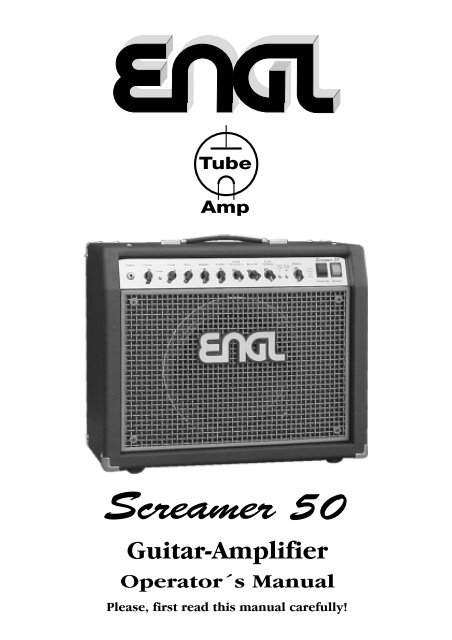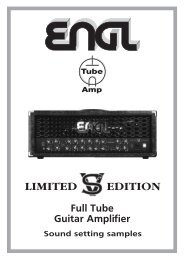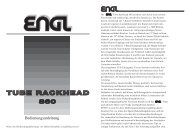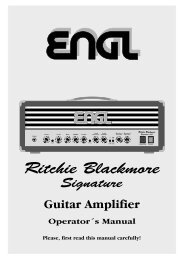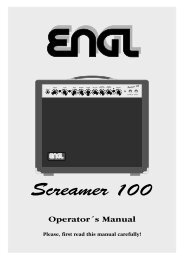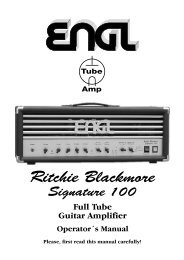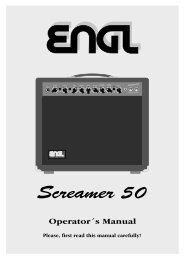Screamer 50 - Engl
Screamer 50 - Engl
Screamer 50 - Engl
Create successful ePaper yourself
Turn your PDF publications into a flip-book with our unique Google optimized e-Paper software.
Tube<br />
Amp<br />
<strong>Screamer</strong> <strong>50</strong><br />
Guitar-Amplifier<br />
Operator´s Manual<br />
Please, first read this manual carefully!
<strong>Screamer</strong> <strong>50</strong> - delivers the sonic goods—tons of tone and palette of hip sounds from squeaky clean<br />
to hi-gain shred and everything in between. This all-tube beast is your first choice for many different<br />
sound styles! With a host of practical features and a clearly-arranged control panel, handling this amp is a<br />
piece of cake. The <strong>Screamer</strong>'s opulent visuals are certainly arresting, but its unique, creamy tube tone and<br />
silky spring reverb truly set this amplifier apart. The <strong>Screamer</strong> comes complete with a bit of technical<br />
wizardry which you'll find useful where it counts most—out there in the real world of rehearsing and<br />
gigging. Among these features are a Lo/Hi Gain switch, which in effect doubles your choice of channels<br />
from two—Clean and Lead—to four—the afore-mentioned, plus Crunch and Heavy Lead. You also get two<br />
different connection systems for different footswitches-conventional ¼" jacks as well as a port for the<br />
ENGL compact footswitch Z-5 (optional). And then there's the ingenious feature "V.L.S.", an adapted<br />
version of the extremely popular and highly practical Master A/B switching circuit found on high-end<br />
ENGL heads.<br />
Quality components, excellent workmanship and strict quality control ensure this amp retains its value.<br />
You'll find guidelines on care and maintenance of tube amps on the last page of the manual.<br />
Please read and heed these before operating your amp. You'll also come across boxes shaded grey<br />
throughout the manual. These are located between the descriptions of the amp's functions and<br />
contain handy tips on the preceding function. All critical information pertaining to the operation of<br />
this amp is preceded by "NOTE" or "CAUTION." Please pay particular attention to these safety tips.<br />
The ENGL team wishes you all the best—may you and your amp enjoy a "harmonically rich" future<br />
together!<br />
Frontpanel<br />
Input<br />
Clean Lead Bass Middle Treble<br />
Bright<br />
Lead<br />
Presence<br />
Lead<br />
Volume<br />
Gain Clean<br />
Lo/Hi Lead<br />
Master<br />
1 2 3 4 5 6 7 8 9 10 11 13 14 15<br />
12<br />
1 Input: Input¼" unbalanced input. Plug your guitar cord in here.<br />
2 Clean: Input sensitivity control (Gain) for the Clean and the Crunch channels.<br />
(Clean: set the Gain-button 11 to the Lo position, Crunch: set the Gain-button 11 to the Hi position).<br />
A TIP from the Designer: Gain settings depend on what type of pickups are installed in your guitar.<br />
The recommended setting for humbuckers or active pickups lies between the 10 and 1 o’clock<br />
positions and 12 to 3 o’clock for single coils for a pure clean response; the Gain button must be in<br />
the OFF-position.<br />
3 Bright: Alters the EQ by boosting the upper treble range; effectiveness decreases at higher<br />
Gain (2,4) settings; the Bright feature affects all channels.<br />
A TIP from the Designer: For a crisp glassy tone, set the Bright switch to the On position. This<br />
setting boosts the treble response of muddy pickups.<br />
4 Lead: Gain control pot for the Soft Lead channel and the Heavy Lead channel. It controls the amount<br />
of preamp overdrive in the Lead mode. (Soft Lead: set the Gain-button 11 to the Lo position, Heavy<br />
Lead: set the Gain-button to the Hi position).<br />
CAUTION: Extremely high gain and volume levels in the Lead mode can produce<br />
strong feedback. Avoid feedback squeals, they lead to hearing loss and damaged speakers!<br />
A TIP from the Designer: To get Crunch-sounds and Rhythm-sounds set this control between<br />
the 9 and 12 o´clock´s position (depending on the type of pick-up) and leave the Gain 11 pusbutton<br />
in the Off-position.<br />
5 Bass: Bottom end voicing control of the preamps´s passive EQ.<br />
6 Middle: Mid-range voicing control of the preamp´s passive EQ.<br />
7 Treble: Upper range voicing control of the preamp´s passive EQ.<br />
A TIP from the Designer: To get an idea of this amp's capabilities, I suggest you set the tone control<br />
pots Bass (5), Middle (6), Treble (7) and Lead Presence (8) to the 12 o'clock position. For extremely<br />
soft lead, blues or jazz sounds, try setting the Treble knob to somewhere in the 8-to-11 o'clock range.<br />
For aggressive metal riffs or spanky funk sounds, go for something in the range of 11 to 3 o'clock.<br />
8 Lead Presence: This control defines the Treble response in the poweramp stage for<br />
the Lead channel.<br />
A TIP from the Designer: When you've adjusted the amp to relatively loud levels and high Gain<br />
settings reduce the amount of Lead Presence (8) and Treble (7) to prevent annoying feedback that is<br />
generated when your guitar's pickups and the speaker interact—something in the 8-to-12 o'clock<br />
range should do just fine.<br />
9 Reverb: Reverb control, adjusts the portion of the reverb signal and increases reverb intensity<br />
if you rotate it clockwise; the reverb can be switched on/off via the respective footswitch connected<br />
to jack 19 or 21.<br />
Reverb<br />
Tube<br />
Amp<br />
<strong>Screamer</strong> <strong>50</strong><br />
Stand By Power
10 Lead Volume: Volume control for the Lead channel (pre-FX loop, influences the Send level). Use<br />
this knob to dial in the desired balance of levels between the Lead and Clean channels.<br />
11 Gain Lo/Hi: When you press this button, the input sensitivity of both channels is increased.<br />
The Hi-Gain function actually turns Clean into a "Crunch" channel, and Lead into a "Heavy Lead"<br />
channel. It can also be activated via a suitable footswitch connected to Jack 19 or 20; the Gain<br />
Lo/Hi button is automatically disabled when you connect a footswitch.<br />
The yellow LED illuminates to indicate "Hi-Gain" mode is active.<br />
12 Clean/Lead: Channel selector pushbutton for Clean and Lead modes, red LED indicate Lead<br />
mode; This function can also be activated via the respective footswitch connected to jack 19 or 20.<br />
Once a footpedal is connected, the channel selector pushbutton is deactivated.<br />
13 Master: Master volume control for power amp output. The feature to switch between two Master<br />
volume levels (V.L.S. - Lo or Hi) can be accessed by means of the respective footswitch connected to<br />
jack 19 or 20. Adjust the ratio between the two volume levels with the "V.L.S. Ratio" pot<br />
(see chapter 18).<br />
14 Stand By: Power amp standby switch: Use this switch to silence (0 position) the amp when you<br />
take a lengthier break. The amp's tubes stay warm, which means that it is ready to roll immediately<br />
when you switch it back to full power. The standby switch is also well-suited for muting the amp for<br />
brief breaks, for instance when you're switching guitars.<br />
15 Power: AC power on/off.<br />
Rear Panel<br />
REPLACE FUSE<br />
ONLY WITH SAME<br />
TYPE AND RATING !<br />
16 17<br />
V.L.S.<br />
RATIO<br />
CUSTOM<br />
FOOTSWITCH<br />
PORT<br />
FOOTSWITCH<br />
CAUTION !<br />
Connect To<br />
Custom CLEAN / LEAD V.L.S.<br />
Footswitch GAIN LO/HI REVERB<br />
Only !<br />
CAUTION ! !<br />
DO NOT OPEN !<br />
RISK OF ELECTRIC SHOCK !<br />
DO NOT EXPOSE THIS<br />
EQUIPMENT TO<br />
RAIN OR MOISTURE !<br />
F.X. LOOP<br />
SEND RETURN BALANCE<br />
DRY EFFECT<br />
All-tube<br />
Guitar Amplifier<br />
<strong>Screamer</strong> <strong>50</strong><br />
COMBO: TYPE E330<br />
HEAD: TYPE E335<br />
Amp-Design by<br />
Horst Langer<br />
MADE IN<br />
GERMANY<br />
POWERAMP OUTPUT<br />
BALANCED LINE OUTPUT<br />
LEVEL LINE OUT<br />
FREQUENCY<br />
COMPENSATED<br />
18 19 20 21 22 23 24 25 26 27 28 29 30 32<br />
31<br />
16 AC Socket: Connect an AC cord here.<br />
CAUTION: Ensure you use an intact AC cord with an insulated plug only!<br />
Before you power the amp up, ensure the voltage value printed beside the<br />
AC socket corresponds to the available current.<br />
17 AC Fuse Box: Contains mains fuse (rear chamber) and spare fuse (front chamber).<br />
NOTE: Ensure replacement fuses bear identical ratings (refer to the table)!<br />
18 V.L.S. Ratio: Use this potentiometer to determine the balance between the two master volume<br />
levels. We deliberately left the knob off this pot, but you can rotate the shaft to dial in the desired<br />
preset. If you're operating the amp without a footswitch, "Master Hi" (high-volume mode) is active<br />
and this pot is disabled. You can switch between the Lo and Hi Master volume levels via a standard<br />
dual footswitch connected to Jack 21 (or via the MIDI Switcher) or the Custom Footswitch<br />
connected to Jack 19. Turn the pot's shaft clockwise to turn up the "Master Lo" level.<br />
19 Custom Footswitch Port: Connect the ENGL Custom Footswitch Z-5 (optional) to this port<br />
(Sub-D, 9-pin). This special footswitch lets you activate the four channels directly via dedicated<br />
buttons. V.L.S. (Volume Level Switching) and reverb are activated via two additional buttons.When<br />
the Z-5 footswitch is connected, the Clean/Lead and Gain Lo/Hi buttons on the front panel as well<br />
as footswitch Jacks 20 and 21 are disabled.<br />
20 Footswitch Clean/Lead, Gain Lo/Hi: 1/4" stereo jack for a dual footswitch, executes the<br />
following functions:<br />
1. Channel switching between Clean and Lead (mono terminal).<br />
2. Gain Lo - Hi: switches from Clean to Crunch during Clean mode and<br />
from Soft Lead to Heavy Lead during Lead mode (stereo terminal).<br />
21 Footswitch V.L.S., Reverb: 1/4" stereo jack for a dual footswitch, executes the following<br />
functions:<br />
1. Switching between the two Master volume levels Hi and Lo (mono terminal).<br />
2. Reverb on/off (stereo terminal).<br />
Impotant Note: You can use standard dual footswitches that connect the mono or stereo contact<br />
of the ¼" jack and its ground. An LED that serves as a status indicator can also be connected in<br />
series (power requirements approx. 10 - 20 milliamperes, depending on function). In practice<br />
though we've found that not every footswitch by every manufacturer under the sun is compatible. If<br />
you choose to use the ENGL Z-3 (basic plastic version without LED display) or ENGL Z-4 (rugged<br />
metal version with LED display) footswitches, you won't encounter any compatibility problems.<br />
R<br />
8 16 OR 16<br />
16 8<br />
AND OR-> OR 8 AND<br />
8 OHMS PARALLEL<br />
1 x 8 OHMS<br />
2 x 16 OHMS<br />
COMBO: INTERNAL SPEAKER<br />
16 OHMS SERIAL<br />
1 x 16 OHMS<br />
(USE LEFT JACK!)<br />
2 x 8 OHMS<br />
GROUND<br />
TO PIN 1<br />
GROUND<br />
LIFTED<br />
LINE OUT<br />
GROUND<br />
OVERLOAD
A TIP from the Designer: If you want to control the amplifier via a MIDI system, use jacks 20 and 21<br />
and a Looper or MIDI Switcher (e.g. ENGL Z-11). Use two stereo ¼" cords to connect the ENGL<br />
MIDI Switcher Z-11 (optional). You can then preset the four switching functions Clean/Lead, Gain<br />
Lo/Hi, V.L.S. and Reverb via the Switcher, store your custom switching setups as different MIDI<br />
programs and activate the presets via a MIDI board (e.g. ENGL Z-12).<br />
22 F.X. Loop Send: Signal output for the Effects loop. Connect this output to a signal processor’s<br />
input/return jack via a shielded cable with 1/4" plugs.<br />
23 F.X. Loop Return: Signal input for the Effects loop. Connect this input to a signal processor’s<br />
output/send jack via a shielded cable with 1/4" plugs.<br />
24 Balance: FX mix control for the Effects loop: Rotate the knob to the "DRY" position for the pure<br />
amp signal, i.e. no effect on the signal. Turn clockwise to blend in an effect connected to the loop<br />
to the dry signal (parallel/passive). At the "EFFECT" position, only the wet signal, i.e. the signal<br />
sent from the FX device is fed to the power amp (serial/passive).<br />
NOTE: If no effects processor is connected to this loop, leave this control in the "DRY" position!<br />
25, 26 Poweramp Output 8 ohms parallel: Parallel 8-ohm speaker outs, connected<br />
internally in parallel. Connect an 8-ohm cabinet or, in the case of the Combo E330, its internal<br />
speaker here. Alternatively, two 16-ohm cabinets can also be connected to these two outputs.<br />
27 Poweramp Output 16 ohms serial: 16-ohm speaker out, connected internally in series<br />
with Jack 28. Connect a 16-ohm cabinet here. Two 8-ohm speakers are connected to Jacks 27 and<br />
28, for example a combination of the internal 8-ohm speaker of the Combo E330 and an external<br />
8-ohm cabinet, e.g. the ENGL models E112 or E412.<br />
CAUTION: If you intend to use a 16-ohm cabinet only, make absolutely certain you<br />
connect it to Jack 27. Jack 28 is only enabled when a speaker is connected to jack 27.<br />
28 Poweramp Output 16 ohms serial: 16 ohms serial. This is an auxiliary output connected<br />
in series with Jack 27. This jack is designed for one application for only—when you are driving a<br />
combination of two 8-ohm cabinets/speakers. This output may only be used when an 8-ohm<br />
speaker is connected to Jack 27. (See the example for Item 27)<br />
NOTE: Never operate the amplifier without a sufficient load, otherwise you may damage<br />
or destroy the power amp! Ensure your cabinet’s specifications match the respective<br />
output’s specs.<br />
Possible speaker combinations:<br />
1 x 8 ohms or 2 x 16 ohms (Jacks 25 and 26) or<br />
1 x 16 ohms (Jack 27!) or 2 x 8 ohms (Jacks 27 and 28).<br />
29 Line Out Ground: This switch assigns Pin 1 of the XLR socket to ground (position "Ground to<br />
Pin 1"). You'll find this option is handy when you want to shield the circuit you have routed to a<br />
mixing console or recording device. In order to come up with an unbalanced signal (e.g. for<br />
feeding the signal to a computer for HD recording purposes), you'll need a cord equipped with an<br />
XLR connector on one end and an RCA connector or ¼" plug on the other. Pin 2 is used to carry<br />
the signal and Pin 1 as the ground (set the switch to the position "Ground to Pin 1"). With this<br />
application—an unbalanced circuit—you may encounter a ground loop caused by the respective<br />
grounds of the two devices, which will generate audible hum.<br />
NOTE: Pin 1 of the balanced line may only be connected to ground on one end<br />
(either at the amp or mixer / recording device), otherwise it may cause a ground loop,<br />
which in turn generates undesirable hum!<br />
30 Level: Signal level control for the frequency-corrected line output; it is used to match<br />
the amp’s signal level at the Line output to the mixing console or recorder’s input.<br />
31 Overload: This LED denotes the Line output is overloading; in this case,<br />
reduce the signal’s level via the Level control.<br />
32 Line Out Frequency Compensated<br />
The frequency-corrected, balanced Line output jack (XLR; Pin 2 and 3 signal, Pin 1 = Ground or<br />
not connected, depending on the setting of switch 29). This signal can be routed directly to a<br />
mixing console or a recording unit. The line out is located post poweramp in the signal chain, so<br />
ensure the poweramp is activated and a load is connected to one of the output jacks.A<br />
A TIP from the Designer: The Line Out’s output level is influenced by the following factors: By the<br />
input level (Gain), the Volume control settings for the various channels, to some degree by voicing<br />
control settings, and by the Master volume level. First dial in the desired sound combination at the<br />
front panel. Then adjust levels at FX devices or signal processors (if connected). Now use the Level<br />
control to adjust the Line level. The Line output is not overloaded until the Overload LED<br />
illuminates brightly and continuously. You can push the level up to this point to match a mixing<br />
console or recorder’s input level requirement. Use the respective device’s input sensitivity or gain<br />
control to fine-tune level adjustments.
The different options for controlling the <strong>Screamer</strong> <strong>50</strong> amp remotely:<br />
REPLACE FUSE<br />
ONLY WITH SAME<br />
TYPE AND RATING !<br />
Clean<br />
Lo Gain<br />
Custom Footswitch<br />
Crunch<br />
Hi Gain<br />
V.L.S.<br />
RATIO<br />
CUSTOM<br />
FOOTSWITCH<br />
PORT<br />
Lead<br />
Lo Gain<br />
Lead<br />
Hi Gain<br />
FOOTSWITCH<br />
CAUTION !<br />
Connect To<br />
Custom CLEAN / LEAD V.L.S.<br />
Footswitch GAIN LO/HI REVERB<br />
Only !<br />
Contour<br />
Reverb<br />
CAUTION ! !<br />
DO NOT OPEN !<br />
RISK OF ELECTRIC SHOCK !<br />
DO NOT EXPOSE THIS<br />
EQUIPMENT TO<br />
RAIN OR MOISTURE !<br />
Custom Footswitch Port<br />
Caution !<br />
Connect To Amplifier Only !<br />
Custom<br />
Footswitch<br />
Type Z-5<br />
Made in<br />
Germany<br />
Serial<br />
Number<br />
Master A/B<br />
Lo/Hi<br />
F.X. LOOP<br />
SEND RETURN BALANCE<br />
DRY EFFECT<br />
ON/OFF ON/OFF<br />
Technical Data:<br />
Rated power: approx. <strong>50</strong> watts at 8 or 16 ohms;<br />
Tubes: V1(input-tube): ECC 83 / 12AX7, FQ Grade;<br />
V2, V3: ECC 83 / 12AX7 selected;<br />
V4: ECC 83 / 12AX7, standard;<br />
V5, V6: 5881 (6L6GC) matched set.<br />
Fuses: external: 1 AT (slow) at 230 Volts;<br />
2 AT (slow) in the 100 and 120 Volts models.<br />
internal: 1,25 AT (slow) at 230 Volts;<br />
2,5AT (slow) in the 100 and 120 Volts models.<br />
Important: Replace fuses only against same type and rating!<br />
Power consumption: 155 watts max.<br />
Dimensions: Combo E330 approx. 57,5 x 48 x 27 cm, (22,6 W x 18,9 H x 10,6 T)<br />
Head E335 approx. 57,5 x 27 x 27 cm, (22,6 W x 10,6 H x 10,6 T)<br />
Weight: Combo: approx. 22 kg (48,4 lbs); Head: approx. 18 kg (39,6 lbs);<br />
Tube array:<br />
Tube Amplifier<br />
All-tube<br />
Guitar Amplifier<br />
<strong>Screamer</strong> <strong>50</strong><br />
COMBO: TYPE E330<br />
HEAD: TYPE E335<br />
Amp-Design by<br />
Horst Langer<br />
MADE IN<br />
GERMANY<br />
Tube Amplifier<br />
ON/OFF ON/OFF<br />
POWERAMP OUTPUT<br />
8 16 OR 16<br />
16 8<br />
AND OR-> OR 8 AND<br />
8 OHMS PARALLEL<br />
1 x 8 OHMS<br />
2 x 16 OHMS<br />
COMBO: INTERNAL SPEAKER<br />
1. or<br />
2. or 3.<br />
R<br />
WRITE<br />
16 OHMS SERIAL<br />
1 x 16 OHMS<br />
(USE LEFT JACK!)<br />
2 x 8 OHMS<br />
MIDI SWITCHER<br />
MIDI<br />
CHANNEL<br />
SWITCH<br />
LOOP 1<br />
GROUND<br />
TO PIN 1<br />
GROUND<br />
LIFTED<br />
LINE OUT<br />
GROUND<br />
SWITCH<br />
LOOP 2<br />
BALANCED LINE OUTPUT<br />
SWITCH<br />
LOOP 3<br />
LEVEL LINE OUT<br />
FREQUENCY<br />
COMPENSATED<br />
1. ENGL Custom Footswitch Z-5: Connect it to the "Custom Footswitch Port" (19) port via a<br />
9-pin computer cable. Functions: Direct access to Clean (Clean & Lo Gain), Crunch (Clean & Hi Gain),<br />
Soft Lead (Lead & Lo Gain), Heavy Lead (Lead & Hi Gain) as well as V.L.S. and Reverb. This is a very<br />
convenient yet compact solution.<br />
2. Dual footswitch (e.g. ENGL Z-4): Connect it to the amp via a stereo ¼" cord. You will need<br />
one dual footswitch for switching channels via Jack 20 and another footswitch for switching<br />
V.L.S. and Reverb via Jack 21. Functions: Clean/Lead, Gain Lo/Hi, V.L.S., Reverb. With this solution,<br />
you can't activate the channels Crunch and Heavy Lead directly, i.e. this requires an intermediate<br />
switching operation.<br />
3. MIDI-Switcher (e.g. ENGL Z-11): Connect the board to the amp via two stereo ¼" cords. The<br />
buttons on the Switcher control Clean/Lead, Gain Lo/Hi, V.L.S. and Reverb. If you program the diverse<br />
switching configurations to different MIDI program locations (e.g. Gain Hi & Lead & Master Lo &<br />
Reverb), you can activate the desired configuration directly via a MIDI board (e.g. ENGL Z-12).<br />
This type of control option is extremely versatile, we recommend it highly if you intend to use the<br />
amp in conjunction with a MIDI system (e.g. MIDI effects devices).<br />
Power<br />
Transformer<br />
V 5<br />
V 6<br />
V4<br />
Reverb-Connector<br />
Output<br />
Transformer<br />
V3 V 2 V1<br />
SWITCH<br />
LOOP 4<br />
OVERLOAD<br />
SWITCH<br />
LOOP 5<br />
SWITCH<br />
LOOP 6
Handling and Care<br />
Protect the amp from mechanical knocks (tubes!).<br />
Let the amp cool down before you transport it (approx. 10 minutes).<br />
Tubes need about 20 seconds to warm up after you switch the power on,<br />
and furtheron a few minutes before they reach their full power capability.<br />
Avoid storing the amp in damp or dusty rooms, they are hard on jacks,<br />
switches and potentiometers.<br />
Make sure air can circulate at the rear and top of the amp<br />
to allow for adequate cooling (increases component life).<br />
Never operate the amp without an adequate load.<br />
Replace tubes with select replacement tubes (special selection criteria) to avoid<br />
microfonic properties, undesireable noise and unbalanced performance.<br />
Attention! Please read the following!<br />
This guitar amplifier can produce high volume levels.<br />
Exposure to high volume levels may cause hearing damage!<br />
Leave tube replacement and power amp biasing to qualified professionals.<br />
Be sure the unit is switched off and unplugged!<br />
Caution! Tubes can get very hot and burn skin when touched.<br />
Always use high quality cables.<br />
Never plug the amp into an ungrounded outlet!<br />
Never bridge a defective fuse and be sure replacement fuses feature<br />
identical ratings!<br />
Pull the AC mains plug before replacing fuses!<br />
Never open the chassis or attempt repairs on your own. Consult qualified<br />
service personnel!<br />
Never expose the amplifier to extreme humidity or dampness!<br />
Please read the instructions carefully before operating the unit!<br />
Be sure to operate and handle this amp as it was designed for. To this end,<br />
please heed the instructions in the operator's manual.<br />
You'll find an additional pamphlet accompanying this owner's<br />
manual entitled "Instruction for the prevention of fire, electric shock<br />
or injury of persons". Be sure to read it before you plug<br />
the preamp in and switch it on!<br />
ENGL Gerätebau GmbH<br />
Internet: www.engl-amps.com<br />
Text, design, grafics, photographies and layout by Horst Langer<br />
We reserve the right to make unannounced technical upgrades!


